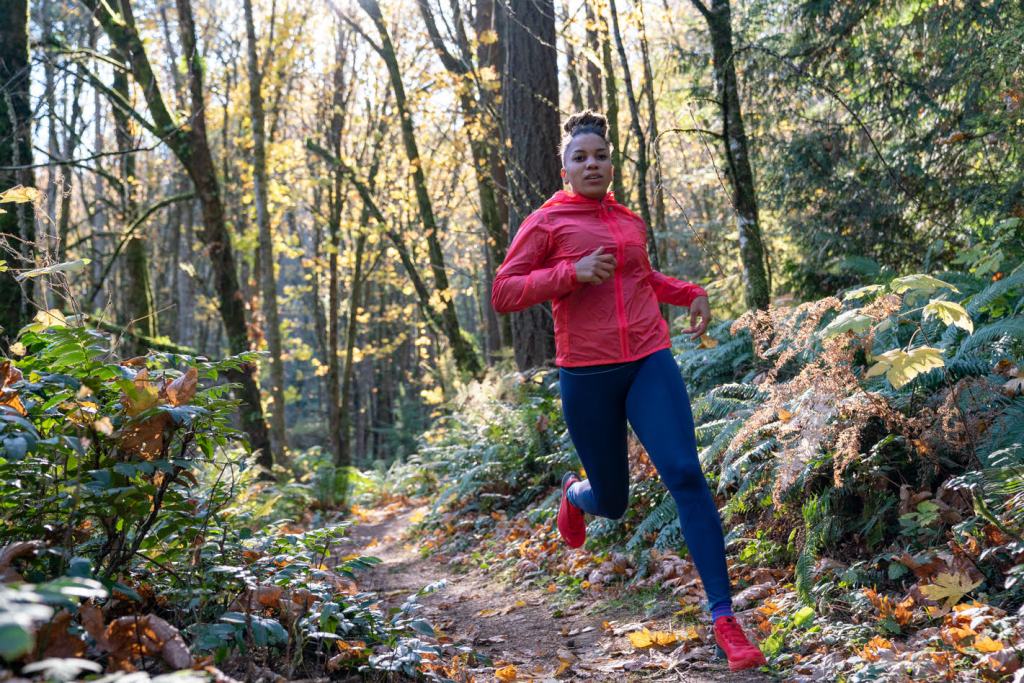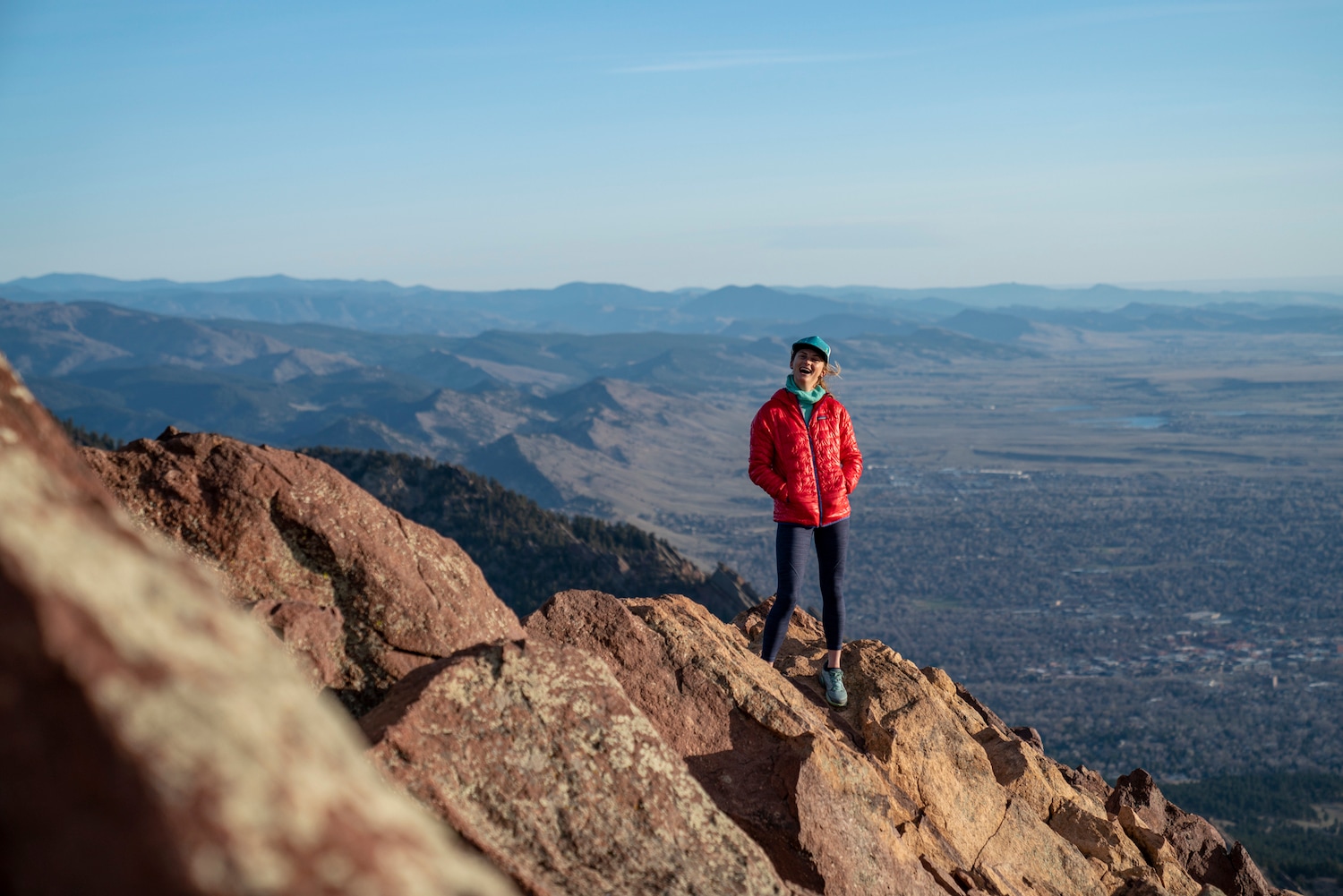Running can feel like a selfish pursuit. As an ultrarunner who spends many miles on the trail, I definitely feel this way sometimes. But many athletes, myself included, run for a bigger purpose. The most important issues to me are addressing the climate and public lands crises. But I wanted to talk to some other runner-activists about what they’re doing to make an impact. Unsurprisingly, they all have habits in common that make them effective changemakers. They stay informed. They are positive and altruistic. And they are constantly organizing.
Alex Falconer
Director of government relations for Save the Boundary Waters, husband, father, Minnesotan, policy nerd.

Alex Falconer during a run across Minnesota’s Boundary Waters Wilderness Area. (Photo Credit: Brendan Davis)
Alex Falconer advocates for the protection of Minnesota’s Boundary Waters Wilderness Canoe Area, America’s most visited wilderness area. This massive zone covers over a million acres of wild land and water. Sulfide-ore copper mines have been proposed on the edge of the wilderness boundary and pollution from these mines could flow directly into the heart of the watershed.
In addition to his work, Falconer is literally running to save the Boundary Waters. He’s crossing the area on foot to raise awareness about this place and the issues affecting it. He’ll combine two epic trails, the Border Route Trail and the Kekekabic Trail, for a 100-mile run next year and he’ll be blogging and posting on social media about the journey.
Lydia Jennings
PhD candidate in soil microbiology at the University of Arizona, Native Outdoors trail running Ambassador, Huichol and Yoeme.

Author Clare Gallagher and Lydia Jennings set out on a 13-mile run on Mount Wrightson in Arizona. (Photo Credit: Brendan Davis)
A soil biologist, Lydia Jennings is improving our planet by restoring degraded ecosystems. “We damage the land with mining to produce metals that we use in our daily lives,” Jennings said. “It’s important that we develop technologies to repair our ecosystems as quickly and as cost effectively as possible.”
When she’s not researching soil through her PhD, she’s educating her communities, both digital and local at home in Tucson, Arizona, about soil ecology, desert ecosystems and Indigenous land stewardship. She also founded the #SkoRunDen trail series, which introduces Indigenous runners to local trails around Arizona.
Faith Briggs
Documentary filmmaker focused on representation, public lands advocate, ran the 400-meter collegiately.

Faith Briggs is in the process of making a documentary about running through six of our country’s National Monuments. (Photo Credit: Michael A. Estrada)
In addition to producing award-winning outdoor-adventure films, like Brotherhood of Skiing, Faith Briggs is running across threatened National Monuments in the U.S. with the hopes of spreading awareness that women, people of color, Indigenous peoples and many others are all stakeholders in the ongoing fight to protect our public lands. “The thought of these spaces being compromised is why we are undertaking this project,” said Briggs. “Not only because we want to, but because we feel we have to.”
In May, Briggs and her crew ran 150 miles through six threatened National Monuments, like Utah’s Bears Ears and Grand Staircase-Escalante, for an upcoming documentary about their journey called “This Land.”
Jared Campbell
Founder of Running Up For Air (RUFA), mechanical engineer, husband, father, a glutton for difficult trail runs.

Jared Campbell (left) running the show at last year’s RUFA on Grandeur Peak in Utah. (Photo Credit: Andrew Burr)
Jared Campbell works as a mechanical engineer, but in the trail running community, he’s known for creating Running Up for Air, a 24-hour run challenge in the middle of February up a mountain in Utah that raises funds via entry fees and donations for improved air quality through the organization, Breathe Utah. It all started with Campbell running laps of Grandeur Peak outside Salt Lake City and taking in views of the polluted air that gets trapped in the valley and can make breathing outside harmful to even the healthiest of runners, let alone people with already compromised lungs.
Last year, RUFA raised over $40,000 for Breathe Utah. Campbell has also served as a mentor for new RUFA events in Colorado and Chamonix, France.
What Can We Learn From These Changemakers?
These four influential runners have expanded their communities’ understanding of local public lands and climate threats and have taught others how to get involved. So, how can we learn from them? Take notes.
Get Informed
These runners are constantly reading, asking questions about issues they care about and involving themselves in solutions. For example, Campbell is already tuned into Salt Lake City’s important mayoral election and advocates through the RUFA community.
When asked what non-profits Briggs recommends looking into for environmental information and news, she replied with no fewer than 17 organizations. Check out Protect Our Winters and Runners For Public Lands. Both have trail running subsects and need organizing energy and networking to connect already-existing trail running efforts with broader organizations.
Stay Positive
It is a privilege to run, so we have a lot to be positive about. This is an important attitude when constantly thinking about the doom and gloom of our climate and public land crises.
“When I get overwhelmed I remind myself of how blessed I am to have the tools and the privilege to be able to use my voice to try to make some kind of contribution,” said Briggs. “I can’t handle the idea that we aren’t going to win this fight.”
Jennings said that running helps her process long lab days and daily stress. She also gets outside for positive perspective. “I know that each step I take on a run is a little prayer for the lands, and that the work I do as an environmental scientist is an important commitment to being a good land steward for future generations,” she said.
It is a privilege to run, so we have a lot to be positive about. This is an important attitude when constantly thinking about the doom and gloom of our climate and public land crises.
Be An Organizer
Until recently, organizing was a new practice for me. I’m not talking about organizing my closet. I mean community organizing, which in essence is the coming together of people in a community.
Trail runners have a lot of organizing opportunities from trail work to greening our races to advocating for public lands and climate policies at the local and national levels. One of my favorite methods is simply one-on-one conversations with people in my community. I find that a meaningful talk with a fellow runner about what Protect Our Winters is doing is often more impactful than a social media blast to thousands.
Falconer is an organizer by trade—he implements tactics like petition signing, calling our representatives and citizen to congressperson lobbying in Washington, D.C.
Jennings’ #SkoRunDen trail events is organizing, as is Campbell’s RUFA. When people get together to run, they also talk and learn, and eventually, they start solving problems.
So, how can you organize? “Remember that our politicians work for us and that every single time we contact them, they have to listen,” Briggs said. “I think the answer is getting more involved, getting on their email lists, following environmental leaders on online platforms, giving the kudos and keeping the pressure on.”
Falconer quoted advice from former U.S. Secretary of the Interior Sally Jewell: “The best way to protect something is to use it.” This is something I emphasize as well: We must keep running.
But Falconer takes it a step further. “Go share your experiences with everyone you can,” he said. “We live in such an amazing time where someone can instantly see your picture and read your account of an incredible landscape from across the world. We have so many important and protected lands and waters, but people won’t care if they don’t know about it.”


